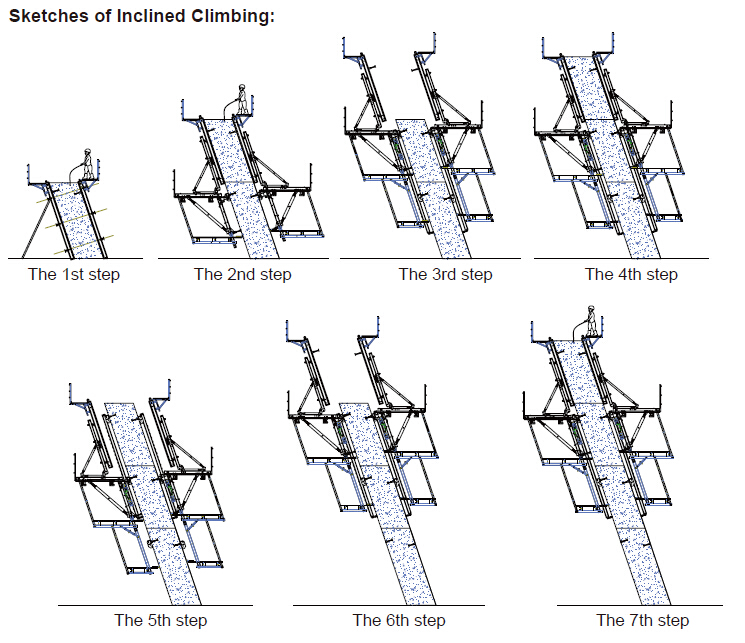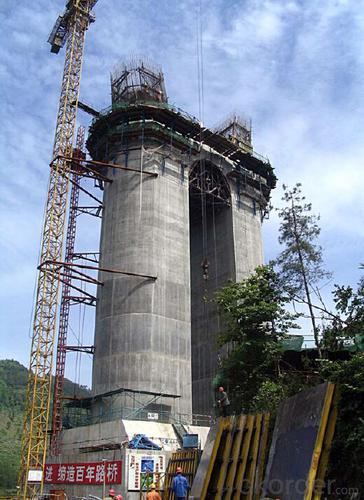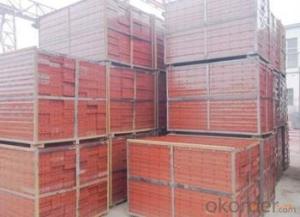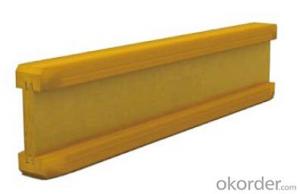Auto Climbing Bracket ACB100&ACB50 for formwork and scaffolding systems
- Loading Port:
- Tianjin
- Payment Terms:
- TT OR LC
- Min Order Qty:
- 50 m²
- Supply Capability:
- 1000 m²/month
OKorder Service Pledge
OKorder Financial Service
You Might Also Like
Auto-climbing Bracket ACB100 & ACB50
The power of the auto-climbing formwork is the hydraulic system, which includes the oil cylinder
and two commutators. The commutators can control the climbing of climbing rail and the bracket.
The steel rail and the bracket can inter-climbing, so the whole system will climb up steadily.
Cranes are not needed during the construction. It’s easy to operate, highly efficient and safe. It’s
the best choice for the construction of high buildings and bridges.
There are mainly two types of standard auto-climbing brackets, ACB-50 and ACB-100, the figure
means the push power of cylinder with unit of KN.
Characteristics:
◆ Perfect load bearing anchor system
Anchor system is the most important supporting part. The system is made of five parts shown
below. Thereinto, tensile bolt, V-climbing cone and washer can be taken out for reusing after the
concrete pouring finished.There are two kinds of anchor systems,A & B. A is matched with single
anchor shoe and B is matched with double anchor shoe.
◆ Crane-independent
Crane-independent forming, striking and climbing speeds up the work procedures on the
construction site and also makes them independent of each other. This means the planned
sequences can be maintained along with guaranteeing high productivity levels. The crane can
therefore be used for other tasks.
Hydraulic system is mainly made of two commutators,
oil cylinder and power distribution system.The
commutators can control the climbing of climbing rail
and bracket.
◆ High bearing capacity and safe
The stable working platforms are able to carry large loads, e.g. the storage of reinforcing steel
for the next climbing section. Generously-sized working platforms, the well thought-out design for
handling very high wind loads and the patented control function of the climbing mechanism are
some of the special details contained within the comprehensive safety concept.
◆ Platforms adjusted to suit the angle of inclination
The horizontal working areas thus created provide safe and comfortable conditions for
reinforcement work, shuttering and striking, concreting and finishing.
◆ The ACB formwork system can climb not only vertically but also slantways, the largest angle is
18 degrees.
◆ The system can climb up wholly or separately. The climbing process is steady, synchronous
and safe.
◆ The bracket will not fall to the ground until the construction is finished, the field will be saved
and the impacting breakage will be reduced (especially the panel).
◆ The system will furnish omnidirectional platform, the construction organizations don’t need to
set up additional operation platform.
◆ The error of structure construction is small and easy to correct.
◆ The climbing speed is fast, the construction course will be quickened.
◆ The formwork can climb itself and cleaning work can be done in the same situs , the used times
of tower crane will be greatly reduced.

- Q: How does steel formwork contribute to the overall moisture resistance of the structure?
- In several ways, steel formwork plays a role in the overall moisture resistance of a structure. Firstly, its design focuses on high durability and resistance to corrosion. This means that it can endure exposure to moisture without deteriorating or compromising its structural integrity. Moreover, tight joints and connections are used in the construction of steel formwork to minimize the possibility of water infiltration. Unlike traditional timber formwork, steel formwork does not shrink or warp when exposed to moisture, guaranteeing the absence of gaps or openings that would allow water to seep into the structure. In addition, protective finishes such as epoxy or galvanized coatings are often applied to steel formwork, providing an additional layer of moisture resistance. These coatings act as a barrier, preventing water from seeping into the steel and reaching the concrete structure. Steel formwork ensures that moisture is prevented from entering the structure by providing a robust and watertight enclosure during the construction process. This is especially crucial for structures that will face external elements, such as bridges or buildings located in humid or rainy climates. In summary, steel formwork's durability, tight joints, and protective coatings contribute to the overall moisture resistance of a structure, ensuring that it remains structurally sound and free from water damage.
- Q: Can steel formwork be used in combination with other types of formwork?
- Yes, steel formwork can be used in combination with other types of formwork. In construction projects, it is common to use a combination of different types of formwork to meet the specific requirements of the structure being built. Steel formwork offers several advantages, such as durability, reusability, and high load-carrying capacity. It is often used for large-scale projects or structures with complex geometries. However, steel formwork can be expensive and heavier compared to other types of formwork. In situations where speed and efficiency are crucial, contractors may choose to use a combination of steel formwork with other types of formwork, such as timber or aluminum. This allows for a more cost-effective approach while still maintaining the desired strength and stability. For example, timber formwork may be used for simpler sections of the structure or areas where the load is relatively light. This can help reduce costs and make the overall construction process more efficient. Steel formwork, on the other hand, can be utilized for critical areas that require higher load-carrying capacity or more complex shapes. The combination of different types of formwork also provides flexibility in terms of design and construction methods. By using steel formwork in combination with other types, contractors can optimize the use of resources, minimize costs, and ensure the successful completion of the project. However, it is important to note that when using a combination of formwork types, proper coordination and planning are essential. Contractors need to ensure that the different types of formwork are compatible and adequately supported to maintain structural integrity. Additionally, proper safety measures should be implemented to protect workers during the construction process. Overall, steel formwork can be effectively used in combination with other types of formwork to achieve the desired construction goals, improve efficiency, and optimize resource utilization.
- Q: Can steel formwork be used in underground construction projects?
- Yes, steel formwork can be used in underground construction projects. Steel formwork is a versatile and durable option for constructing structures below the ground level. It offers several advantages over other types of formwork, such as timber or aluminum, making it a preferred choice for underground construction. One of the key benefits of steel formwork is its strength and rigidity. Underground structures often require a high level of structural integrity to withstand the pressure and weight of the surrounding soil or water. Steel formwork provides the necessary strength and stability to support the concrete during the casting process and throughout the life of the structure. Additionally, steel formwork is highly resistant to moisture, which is a critical factor in underground construction. The underground environment is typically damp and can result in the deterioration of formwork materials. Steel, being a non-porous material, does not absorb moisture, ensuring that the formwork remains intact and functional even in such conditions. Moreover, steel formwork is reusable, making it a cost-effective option for underground construction projects. The ability to reuse formwork multiple times reduces the overall project expenses and minimizes waste generation. This is particularly beneficial in underground projects where formwork removal and reinstallation can be challenging due to limited access. Furthermore, steel formwork offers excellent dimensional stability, ensuring accurate concrete placement and precise shaping of the structure. This is crucial in underground construction where precise measurements and alignment are necessary for proper functioning and safety of the project. In conclusion, steel formwork can definitely be used in underground construction projects due to its strength, moisture resistance, reusability, and dimensional stability. Its ability to withstand the demanding conditions of underground environments makes it a reliable and efficient choice for constructing underground structures.
- Q: How does steel formwork affect the overall stability of the structure?
- Steel formwork is a crucial component in the construction industry, and it plays a significant role in determining the overall stability of a structure. When compared to other formwork materials, such as wood or plastic, steel formwork offers superior strength, durability, and stability. One of the key ways in which steel formwork affects the overall stability of a structure is by providing rigid support to the concrete during the pouring and setting process. The strong and sturdy nature of steel ensures that the formwork remains in place, preventing any deformation or collapse. This stability is particularly important during the curing phase when the concrete gains strength and hardens. The steel formwork acts as a temporary structure, holding the concrete in place until it becomes self-supporting. Moreover, steel formwork facilitates the proper alignment of the concrete, resulting in a well-defined and stable structure. The precise dimensions and tight joints of steel formwork ensure that the concrete is poured in a controlled manner, eliminating any potential for irregularities or weaknesses in the structure. This level of accuracy and stability is essential in critical areas such as load-bearing walls, beams, and columns. Additionally, steel formwork provides resistance against external forces and environmental factors that can affect the stability of a structure. The inherent strength of steel makes it highly resistant to bending, twisting, and warping, ensuring that the formwork remains intact under the weight of the concrete and any imposed loads. Steel formwork also offers excellent resistance to moisture, temperature variations, and chemical exposure, which can compromise the stability of other formwork materials. Furthermore, the reusable nature of steel formwork makes it a cost-effective and sustainable choice. Its durability allows for multiple uses, reducing the need for frequent replacements and minimizing construction waste. This aspect contributes to the overall stability of the structure as it ensures consistency in formwork quality throughout the project, avoiding any potential variations in stability that might arise from using different materials or techniques. In conclusion, steel formwork significantly impacts the overall stability of a structure. Its strength, durability, and rigidity provide the necessary support and alignment for the concrete, ensuring a stable and well-defined structure. The resistance to external forces and its ability to withstand environmental factors further enhance the stability of the formwork system. Ultimately, steel formwork is an indispensable component in the construction industry, contributing to the overall safety and longevity of structures.
- Q: How does steel formwork affect the overall stability of a structure?
- The overall stability of a structure is greatly influenced by steel formwork. Formwork, which is temporary molds or frameworks used to shape and support wet concrete until it becomes self-supporting, plays a vital role. Steel formwork offers numerous advantages that positively impact the stability and strength of the structure. To begin with, steel formwork possesses exceptional strength and durability compared to materials like wood or plastic. This high strength enables steel formwork to withstand the pressure from wet concrete without deforming or collapsing. As a result, the stability of the structure is enhanced because the formwork maintains its shape and rigidity during the concrete pouring and curing process. Furthermore, steel formwork provides better dimensional accuracy and consistency. Its rigid nature prevents any movement or shifting, ensuring that the concrete is poured and cured in the desired shape and dimensions. This precise accuracy is crucial for maintaining the structural integrity and stability of the final construction. Moreover, steel formwork allows for greater design and construction flexibility. It can be easily customized and shaped to meet the specific requirements of the structure, allowing architects and engineers to create intricate and unique designs. This flexibility enhances the overall stability of the structure by enabling efficient load distribution and reinforcement placement. Additionally, steel formwork exhibits excellent load-bearing capacity. It efficiently distributes the weight of the wet concrete, as well as any additional loads imposed during construction such as workers, equipment, or construction materials. This load-bearing capacity ensures that the structure remains stable and can withstand the imposed loads without compromising its integrity. Lastly, steel formwork has a longer lifespan compared to other formwork materials. Its durability and resistance to deterioration increase the overall stability of the structure over time. Steel formwork can be reused multiple times, reducing waste and costs while maintaining the desired stability and quality of the finished construction. In conclusion, steel formwork plays a significant role in enhancing the overall stability of a structure. Its strength, dimensional accuracy, flexibility, load-bearing capacity, and longevity ensure that the formwork maintains its shape and rigidity, supporting the wet concrete and allowing it to cure properly. By providing a solid and reliable foundation, steel formwork enhances the stability and strength of the structure, ensuring its long-term durability.
- Q: Can steel formwork be used for both single-storey and multi-storey buildings?
- Indeed, the utilization of steel formwork is applicable for single-storey and multi-storey constructions alike. This flexible method permits effortless modifications and tailoring to accommodate diverse building dimensions and configurations. With its exceptional robustness, endurance, and steadfastness, steel formwork proves to be a suitable choice for erecting both single-storey edifices and multi-storey complexes. As a result, the implementation of steel formwork facilitates swifter construction while ensuring a polished and top-notch appearance for concrete structures. Furthermore, the reusability aspect of steel formwork renders it a cost-effective and sustainable option for both single-storey and multi-storey building projects.
- Q: Is steel formwork suitable for projects with high formwork reusability?
- Yes, steel formwork is suitable for projects with high formwork reusability. Steel formwork is known for its durability and strength, which allows it to withstand multiple uses without significant wear and tear. It can be easily assembled and disassembled, making it efficient for reuse on different projects. Additionally, steel formwork provides a smooth and consistent finish to concrete structures, ensuring high-quality results. While the initial cost of steel formwork may be higher compared to other types of formwork, its long lifespan and reusability make it a cost-effective solution for projects requiring frequent formwork reuse.
- Q: How does steel formwork handle form release agents?
- Compared to other types of formwork, such as wood or plastic, steel formwork has a different way of dealing with form release agents. The surfaces of steel formwork are typically smooth and non-porous, which makes it easier to apply and spread form release agents evenly. Before pouring concrete, form release agents are substances that are applied to the surfaces of the formwork. Their main purpose is to prevent the concrete from sticking to the formwork, making it easier to remove the formwork once the concrete has hardened. Steel formwork provides an excellent surface for applying form release agents. The smooth and non-absorbent nature of steel allows the release agent to create a thin film or coating on the surface, ensuring a clean separation between the concrete and the formwork. To properly apply form release agents on steel formwork, it is important to follow the instructions provided by the manufacturer. Typically, a sprayer or brush is used to evenly distribute the release agent onto the steel surface. It is crucial to apply enough release agent to ensure complete coverage, as insufficient application may result in the concrete sticking to the formwork. One advantage of steel formwork is its reusability, which means that form release agents need to be reapplied for each use. Once the concrete has set, the formwork can be easily removed, and any remaining form release agent can be cleaned off the steel surface. This allows the formwork to be used multiple times, saving costs and improving efficiency in construction projects. In conclusion, steel formwork effectively handles form release agents due to its smooth and non-porous surface. The even application of form release agents on steel formwork ensures a clean separation between the concrete and the formwork, making it easier to remove after the concrete has hardened. The reusability of steel formwork also allows for multiple applications of form release agents, reducing costs and improving efficiency in construction projects.
- Q: What are the typical sheet thicknesses used in steel formwork panels?
- The typical sheet thicknesses used in steel formwork panels vary depending on the specific application and requirements, but they commonly range from 2mm to 6mm.
- Q: Can steel formwork be used in architectural concrete projects?
- Yes, steel formwork can be used in architectural concrete projects. Steel formwork offers several advantages such as durability, reusability, and the ability to create complex shapes and designs. It provides a smooth and consistent finish to the concrete surface, making it suitable for architectural applications where aesthetics are important. Additionally, steel formwork can withstand high pressure and load, allowing for the construction of large and structurally sound concrete elements.
Send your message to us
Auto Climbing Bracket ACB100&ACB50 for formwork and scaffolding systems
- Loading Port:
- Tianjin
- Payment Terms:
- TT OR LC
- Min Order Qty:
- 50 m²
- Supply Capability:
- 1000 m²/month
OKorder Service Pledge
OKorder Financial Service
Similar products
Hot products
Hot Searches




















